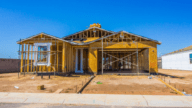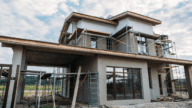Buy a New Construction Home Using These 14 Tips from a Top Agent
- Published on
- 11 min read
-
 Steph Mickelson, Contributing AuthorClose
Steph Mickelson, Contributing AuthorClose Steph Mickelson Contributing Author
Steph Mickelson Contributing AuthorSteph Mickelson is a freelance writer based in Northwest Wisconsin who specializes in real estate, building materials, and design. She has a Master's degree in Secondary Education and uses her teaching experience to educate and guide readers. When she's not writing, she can be found juggling kids and coffee.
-
 Taryn Tacher, Senior EditorClose
Taryn Tacher, Senior EditorClose Taryn Tacher Senior Editor
Taryn Tacher Senior EditorTaryn Tacher is the senior editorial operations manager and senior editor for HomeLight's Resource Centers. With eight years of editorial and operations experience, she previously managed editorial operations at Contently and content partnerships at Conde Nast. Taryn holds a bachelor's from the University of Florida College of Journalism, and she's written for GQ, Teen Vogue, Glamour, Allure, and Variety.
Buying a new construction home can be intimidating. While the builder will have options to choose from, you’ll still have a lot to decide on; you’ll need to choose a floor plan, decide on upgrades, find financing, and make decisions that you may not have expected to have to make. If all of that seems too overwhelming, you can opt to buy a new construction home that’s already built and ready for you to move into.
We did the research and spoke with Daniel Del Real, a top real estate agent in Modesto, California, to provide you with all the tips for buying a new construction home.
1. Find a buyer’s agent who works with new construction
As with any real estate transaction, finding an agent who specializes in the type of home you’re looking for is key to success. When you begin your search for an agent, focus on those who routinely work with new construction homes.
Even though you may have the option to buy a new construction home directly from the builder without the help of an agent, it’s important to consider the benefits that you’ll receive when you work with a buyer’s agent. Some of these include:
- The agent can help you decide on a development that will meet your needs and give you insights to benefits, drawbacks, amenities, and HOA requirements.
- They may have established relationships with builders in the area and can help you negotiate with the builder to ensure you’re getting what you want.
- They are a third party with no emotional connection to the process, so they can help you make decisions more objectively.
- They can help you manage the timeline, choosing upgrades, inspections, and closing.
HomeLight’s Agent Match Tool will connect you with three qualified agents in your area in just two minutes. From there, you can decide who will be the best fit.
2. Shop around for a mortgage lender
All mortgage lenders are not the same. The builder may have a preferred lender, and that’s a good place to start — but it’s important to get preapproved with more than one lender to see who is offering the best terms for your particular circumstances.
In Del Real’s experience “you should always shop around and get a different opinion, but if the builder is willing to give you a credit to buy down your rate and can get you better terms, I would lean on the credit from the builder.” Essentially, he says “trust, but verify and get a secondary opinion just in case.”
Preapproval can take as little as one business day once you’ve submitted all of your documentation. Once you’re preapproved, you can compare each lender’s rates, terms, and closing costs.
The mortgage company will pull your credit score, which could lower it temporarily, but depending on the credit-scoring model the lender uses, multiple credit checks within a short time frame may only be counted as one inquiry.
3. Research the builder
Be sure to do your research on prospective builders. Look at their previous developments and find reviews about the neighborhoods and the building process itself. You can also do some general Google searches to see if you can uncover any lawsuits or bigger issues that could affect the work they do on their homes.
Some things to look for include:
- The experience of past clients. Were they happy with the process?
- Are there issues that keep popping up in different reviews?
- Can you find information about their process and the materials they use?
- How many homes and developments have they built?
4. Research the neighborhood
Once you’ve narrowed down your builder and neighborhood options, do some digging into what your potential neighborhood has to offer. If the neighborhood is brand new and still being developed, look into what amenities you will have access to — a pool, parks, walking trails — and take a drive through the area to see what’s nearby. Walk through the grocery store, stop at a coffee shop, and check out the nightlife (or daylife).
If the neighborhood is already well established, get in there! Take a walk, take your kids to the park, chat with potential neighbors, and drive to your work from the area to see what the commute time will be. You can also use social media to dig even further into what neighborhood life is like. Check to see if the neighborhood is on Nextdoor or if there’s a Facebook page — though you may not be able to join either until you actually live in the neighborhood.
Another aspect to look into is the neighborhood’s homeowners association (HOA). The HOA may have a website that you can refer to, or you can contact the HOA directly, to find out what the monthly fees are. Be sure to also take a look at the covenants, conditions, and restrictions (CC&Rs) to see what is allowed and what isn’t. Some HOAs are stricter than others, so you want to be sure you know what you’re getting into and what advantages they offer you as a potential homeowner.
5. Choose your lot — and be picky
In any given development, there are different lots to choose from. When it’s time to choose yours, pay close attention to:
- The features of the lot. Some lots will be labeled or categorized based on what kind of home you are able to build on it. For instance, a flat lot, a lookout lot, or a walkout lot.
- How the home will be oriented. Is it facing the sunrise or sunset? What will the view be from the places you’ll spend the most time?
- How the slope will affect drainage. If the lot is sloped, discuss the builder’s plans for drainage to protect the home from flooding.
- How close it is to the main road. Stand on the lot for a while to assess how much traffic passes by during any given time. If you prefer more privacy, choose a lot at the end of a cul-de-sac or at least further from the main road.
6. Choose your floor plan wisely
This is where the process starts to get exciting! When it’s time to choose a floor plan, here are a few things to consider:
- Current needs. Do you need an office space or a massive kitchen for cooking for large groups? How many bedrooms do you need? Do you want a finished basement?
- Future needs. If you’re planning on expanding your family, how much space will you need? Do you plan on having in-laws or your parents move in at some point in the future and need to consider accessibility? Are you building a business and need an office or workshop space?
- Storage. Consider how much storage you currently have, and use that as a jumping off point for how much storage space you’ll need in your new home.
- Maximize your space and flow. If you’re working with a smaller floor plan, consider an open concept to make the space feel larger. Do an imaginary walkthrough to see if the floor plan will suit your lifestyle.
Often builders will offer standard floor plans with customization options or you can work with them to design a custom plan.
7. Read the fine print
When you ultimately choose a builder, a neighborhood, and are getting ready to sign a contract, be sure to read the fine print in any documents from your builder. Doing this will ensure you know what is included and what’s not. Pay close attention to the details such as appliance packages, lighting, and landscaping.
This is where your agent can come in handy — having someone on your team who understands these contracts will be your best bet for getting a great deal on your dream home.
8. Negotiate everything you can
Even if you’re working with a builder who seems to be firm in their plans and prices, it’s still possible to negotiate and ensure you’re getting the best deal for you. Some portions of the build you might be able to negotiate include:
- Financing
- Floor plans
- Upgrades and fixtures
- Warranties
- Appliances
This is especially true if you see that the market is slow in your area or if the builder begins offering incentives to work with them. When it’s time to negotiate, Del Real suggests negotiating on upgrades or credits for interest rate reduction rather than the actual price of the home. Most builders will not be willing to budge on the final price of the home, as this might set a precedent for future home prices in their development.
The biggest expenses that people are going to have and the biggest bang for your buck are kitchens and backyards. If you can do upgrades in the kitchen, you’re always going to get a great return on your kitchen.
 Daniel Del Real Real Estate AgentClose
Daniel Del Real Real Estate AgentClose Daniel Del Real Real Estate Agent at PMZ Real Estate Currently accepting new clients
Daniel Del Real Real Estate Agent at PMZ Real Estate Currently accepting new clients
- Years of Experience 22
- Transactions 1658
- Average Price Point $267k
- Single Family Homes 1602
9. Choose upgrades that increase the home’s value
Some upgrades may look nice, but might not increase the home’s value. When you’re choosing more expensive upgrades and features, it’s important to work with your agent to decide which features will get you a higher return on your investment when (or if) you sell down the line.
“The biggest expenses that people are going to have and the biggest bang for your buck are kitchens and backyards,” says Del Real. “If you can do upgrades in the kitchen, you’re always going to get a great return on your kitchen.”
10. Expect delays and plan accordingly
The new construction process isn’t as cut and dried as moving into an existing home. Unforeseen circumstances such as weather, natural disasters, and supply shortages can impact even the best builders.
If you need to be out of your previous home before you’re able to move into your newly constructed home, make sure you have a backup plan in place. You can apply for a short-term rental, stay with family or friends, or even book a hotel if you just need a few days. Make sure you also know your options for storing your things in the event you can’t move in right away.
11. Ask for leftover materials to keep on hand
If the builder has leftover paint, carpet swatches, trim pieces, shower tiles, or flooring, they may be able to leave some behind so you can use them for repairs and touch ups later on.
12. Manage your expectations
When you toured the model home, you probably fell in love with the shiny new features and impeccable decoration — maybe you even imagined yourself living in a home just like that one. But keep in mind that model homes are usually decked out with all of the upgrades and staged to perfection, and not every upgrade in the model home is going to be worth the extra money you spend on it. Your home may look and feel different, and that’s ok.
13. Get a home inspection
A home inspection is always a good idea, even for a new construction home. Even the best builders make mistakes, and your home can end up having some issues that you’ll want to have addressed before closing. You will have to pay for inspection, but that’s really the only downside.
Some common issues such as incorrectly applied siding, cracks in the drywall, or humidity inside the home can be identified during the inspection, and you (with the help of your agent) can address these with the builder.
14. Keep all warranty documents
One of the great things about buying a new construction home is that everything is brand new and much of it is under warranty. Make sure you keep all warranty documents, including implied warranties, express warranties, and manufacturer’s warranties to make sure you’re prepared in case something breaks or is defective.
Buying new construction can be difficult — but worth it
Buying a new construction home comes with many decisions. It can be trickier than purchasing an existing home because in many cases, you won’t actually see it until after it’s built. However, it also means you’ll be living in a brand-new home that you can make entirely your own. Working with a buyer’s agent and builder you trust will help to ensure the process goes smoothly and you are happy with the end result.
Header Image Source: (Breadmaker / Shutterstock)








